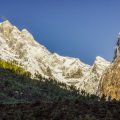1. Introduction: The Pulse of Indian Wilderness
India, with her vast jungles, sprawling grasslands, and sacred rivers, is a tapestry woven with life. From the mighty Himalayas to the lush Western Ghats, every corner holds an ancient story whispered by rustling leaves and wandering wildlife. For centuries, local communities have shared an unbreakable bond with these wild spaces—a relationship that is both spiritual and practical. In many Indian villages, people see themselves as caretakers rather than conquerors, understanding the delicate rhythms of nature through generations of observation and respect.
Within this unique cultural landscape, Indian trackers stand as silent guardians of the wilderness. Their knowledge is not merely learned from books but inherited like family heirlooms—passed down through stories by the fireside, through footsteps pressed into forest trails, and through hearts attuned to the language of birdsong and paw prints. Trackers are more than guides; they are interpreters of nature’s secrets. Their role in wildlife research is vital in preserving Indias rich biodiversity. As forests face new challenges—from habitat loss to climate change—the wisdom of these trackers forms the pulse that sustains the heart of India’s ecosystems.
Wisdom Passed Down: Traditional Tracking Skills
In the heart of India’s wild landscapes, the art of tracking is not merely a skill but a deep-rooted tradition. The indigenous communities like the Pardhis from central India and the Soligas of Karnataka have preserved a priceless heritage—an intimate knowledge of the jungle, passed down through generations. Their wisdom forms the backbone of wildlife research, bringing together ancient practices and modern conservation.
Indigenous Knowledge Systems
For these trackers, every rustle in the grass, every broken twig, or fading footprint tells a story. Their expertise is not learned from books but inherited through oral traditions and experiential learning. The Pardhis, for example, are known for their incredible ability to read subtle signs left by animals, while the Soligas navigate dense forests guided by an innate sense of direction and harmony with nature.
Unique Tracking Methods
The methods employed by Indian trackers are both unique and effective. They rely on:
- Listening to bird calls to detect animal movement
- Identifying scat and pugmarks for species identification
- Reading patterns in foliage disturbances
- Using traditional tools made from local materials
These skills are honed over years of living closely with the land, making their observations invaluable for researchers seeking elusive species or studying animal behaviour.
Table: Comparing Tracking Traditions
| Community | Main Region | Special Skillset | Cultural Belief |
|---|---|---|---|
| Pardhi | Madhya Pradesh, Maharashtra | Pugmark reading, sound mimicry | “Jungle is our ancestor” |
| Soliga | Karnataka (Biligiri Rangaswamy Hills) | Navigation without maps, herbal knowledge | “Forest spirits guide us” |
This rich heritage is not just about finding animals—it is about respecting the interconnectedness of all life in the forest. As Indian trackers walk barefoot along forgotten trails, they become living bridges between the past and future of wildlife research, carrying forward wisdom that science alone cannot capture.

Bridging the Gap: Trackers and Modern Conservation
In the vast wilderness of India, a unique partnership is blossoming—a collaboration where the ancient art of tracking meets modern conservation science. Indian trackers, with their inherited wisdom and deep-rooted connection to the land, are bridging the gap between traditional knowledge and advanced research methods. Across reserves from Madhya Pradesh’s sal forests to the grasslands of Gujarat, these skilled individuals work hand-in-hand with scientists, forest officers, and NGOs. Their role goes far beyond simply following animal footprints; they become the eyes and ears on the ground, often noticing subtle signs that drones or camera traps might overlook.
Trackers’ intimate understanding of animal behaviour and seasonal changes allows them to spot shifts in wildlife populations long before data appears in official reports. When a herd of elephants changes its migration route or a tiger marks new territory, trackers are usually the first to sense these movements. They relay this information to researchers and forest officers, guiding teams to critical habitats and alerting authorities about possible threats like poaching or habitat encroachment. This local intelligence is vital for rapid response and effective management of protected areas.
NGOs working across India have recognized the value of these partnerships. Projects monitoring endangered species such as the Asiatic lion in Gir or the elusive snow leopard in Ladakh regularly depend on trackers’ field insights. These collaborations aren’t just functional—they are also respectful exchanges where scientific tools like GPS collars and camera traps complement, rather than replace, traditional skills. The result is a holistic approach: data collected by technology is interpreted through the lens of local experience, ensuring that conservation efforts remain rooted in real-world contexts.
The synergy between trackers and modern conservationists exemplifies India’s unique path—one where progress does not mean forgetting heritage, but rather weaving it into a new fabric of understanding. In their quiet footsteps through forests and valleys, Indian trackers remind us that sometimes, the most advanced tool we have is human intuition honed over generations.
4. The Art of Reading the Land
In the heart of India’s dense forests and sprawling grasslands, local trackers embody a unique skill—the art of reading the land. For these experts, each dawn begins with a silent dialogue with nature. Their day-to-day experiences are deeply rooted in traditions passed down through generations, harmoniously blending ancestral wisdom with modern wildlife research.
Interpreting Pugmarks: Footprints as Forest Stories
Pugmark tracking is one of the most essential tools in a tracker’s repertoire. Each footprint—be it from a tiger, leopard, or chital—tells a distinct story. Trackers scrutinise the depth, shape, and stride length to infer not only the species but also its age, gender, and even emotional state. In Hindi and many regional languages, this practice is often known as pug chinh dekhna. Below is a simplified table showing how trackers interpret pugmarks:
| Animal | Pugmark Characteristics | Insights Gained |
|---|---|---|
| Tiger (Bagh) | Large, rounded toes; deep heel mark | Adult male; solitary movement; recent passage |
| Leopard (Tendua) | Smaller, narrower pad; closer toe alignment | Younger animal; agile movement; possible hunt nearby |
| Chital Deer (Chital) | Split hoof; lighter impression | Group presence; calm behaviour; grazing area identified |
Listening to Calls: The Forest’s Soundtrack
Apart from visual cues, Indian trackers rely heavily on their acute sense of hearing. Early morning often echoes with alarm calls—a langur’s sharp bark or a sambar’s urgent whistle. These sounds signal potential danger or predator movement. Trackers refer to these alarm calls as sanket dhwaniyan, using them to triangulate animal locations or warn researchers about lurking tigers or elephants.
Sensing Subtle Changes: The Intuitive Connection
The land speaks not just through footprints or sounds but also through subtle shifts—crushed leaves, disturbed mud, or a sudden hush among birds. A seasoned tracker senses these changes intuitively, drawing upon years of lived experience in the jungle. This skill is often described by locals as jungle ki bhavana ko mehsoos karna, meaning ‘to feel the pulse of the forest’.
A Tracker’s Daily Rhythm: Step by Step Fieldwork
| Time of Day | Main Activities | Cultural Practice/Term Used |
|---|---|---|
| Dawn (Subah) | Pugmark inspection along trails & waterholes | Pug chinh dekhna (पग चिन्ह देखना) |
| Mid-morning (Dopahar) | Listening for alarm calls; observing animal behaviour from hides (Machaans) | Sanket dhwaniyan sunna (संकेत ध्वनियां सुनना) |
| Dusk (Shaam) | Sensing changes; mapping animal movements for researchers’ records | Jungle ki bhavana ko mehsoos karna (जंगल की भावना को महसूस करना) |
The Human-Nature Connection in Every Step
Their work is more than technique—it is an ongoing conversation between human and habitat. Through interpreting signs invisible to most eyes and ears, Indian trackers become the bridge that connects traditional knowledge systems with scientific inquiry. Their daily fieldwork—rich in observation and intuition—ensures that every step taken in India’s wild spaces brings us closer to understanding and conserving its magnificent biodiversity.
5. Respect and Recognition: The Trackers’ Challenges
Across the vibrant jungles of India, trackers walk quietly, interpreting the earth’s language in ways science alone cannot teach. Yet, despite their deep-rooted expertise and pivotal role in wildlife research, Indian trackers often grapple with a profound lack of formal recognition. Their skills—passed down through generations—remain undervalued, their voices seldom heard in policy circles or scientific publications.
Socially, many trackers hail from forest-dwelling communities and indigenous groups who have historically faced marginalization. The contributions of these communities are frequently overshadowed by researchers and officials who receive public accolades for conservation successes. Without formal acknowledgment or fair compensation, trackers must navigate economic uncertainty while carrying the emotional weight of being uncelebrated heroes.
There is also the challenge of preserving traditional knowledge. As modern conservation leans heavily on technology and academic credentials, the oral wisdom of the trackers risks fading away. This lack of respect not only affects their morale but also jeopardizes the continuity of their unique skills—skills that are crucial for monitoring elusive species and understanding subtle ecological changes.
Community empowerment stands as a pressing need. Initiatives that celebrate trackers heritage, provide avenues for skill certification, and ensure equitable involvement in decision-making are essential. By honouring their unsung role, India’s conservation movement can build trust and foster a deeper sense of stewardship within local communities. True progress lies in bridging the gap between field experience and institutional frameworks.
To truly acknowledge Indian trackers is to weave their stories into the larger narrative of wildlife protection—a narrative that respects tradition as much as innovation. By giving due respect and recognition, we not only uplift those at the heart of India’s forests but also secure a richer, more inclusive future for conservation itself.
6. Nurturing the Next Generation
In the heart of India’s wild landscapes, a quiet revolution is taking place. The traditional tracking communities—often from families who have walked forest trails for generations—are now being encouraged to pass their invaluable skills to the youth. This nurturing of the next generation is not just about preserving a cultural legacy; it is an essential step in strengthening wildlife research across the subcontinent.
Encouraging Youth Participation
The elders in many tribal and rural communities, such as the Pardhi, Soliga, and Baiga, recognize that their way of reading footprints, animal calls, and subtle changes in the forest is at risk of being lost. NGOs and conservation agencies are collaborating with these communities to ignite curiosity among young people, blending storytelling with field experiences. School programs, workshops in local languages like Hindi, Marathi, or Kannada, and intergenerational nature walks are becoming more common. Such efforts help bridge the gap between ancient knowledge and modern conservation needs.
Capacity Building for Future Trackers
Capacity building goes beyond simple skill transfer. Young trackers are being trained in documentation techniques, basic ecology, and even public speaking so they can share insights with researchers and tourists alike. Organisations offer internships and scholarships to those from tracking backgrounds, empowering them to become field guides or research assistants. This not only provides livelihood opportunities but also places traditional wisdom at the centre of scientific inquiry.
Blending Technology with Ancestral Wisdom
The new generation stands at a unique crossroads—where satellite collars meet spoor identification, and GPS mapping complements oral histories. Training sessions often include hands-on practice with camera traps, mobile data collection apps (like eBird or M-STrIPES), and digital photography. Yet, elders remind them that no technology can replace the intimate understanding of animal behaviour honed over years in the jungle. It is this blend—of smartphone and sandalwood—that is setting Indian wildlife research apart.
Nurturing the next generation of Indian trackers means weaving together pride in heritage with access to new tools. As these young men and women stride into forests from Ranthambhore to Kaziranga, they carry both tradition and innovation—ensuring that India’s wildlife has vigilant guardians for decades to come.
7. Conclusion: Weaving New Stories for Indian Jungles
As the sun dips behind the sal and teak trees, painting the Indian jungles in hues of gold, it is a fitting moment to pause and reflect on the quiet heroes walking these sacred lands — our Indian trackers. Their footprints are more than marks on red earth; they are living stories, woven from generations of wisdom, deep intuition, and an unbreakable bond with nature. The role of trackers in wildlife research has been vital, their eyes sharper than any camera trap, their ears attuned to the rustle of every leaf and call of every bird. They are not merely guides or assistants; they are repositories of knowledge that cannot be learned from books or laptops under city lights.
Looking ahead, the future of India’s conservation efforts lies in recognising trackers not just as contributors, but as central voices in decision-making. Imagine a new era where research teams begin with a tracker’s perspective, where forest management plans honour their insights, and where every discovery carries the resonance of their lived experiences. This is not only about justice or inclusion — it is about making conservation truly effective and deeply rooted in local realities.
In this slow journey toward ecological harmony, we must walk hand-in-hand with those who have always listened to the language of the jungle. Let us commit to platforms where trackers’ stories shape policies, where their children see value in following ancestral paths, and where respect for indigenous wisdom becomes the heartbeat of Indian wildlife research. Only then can we hope to write new stories for our jungles — stories that echo with pride, belonging, and hope for generations yet to come.

